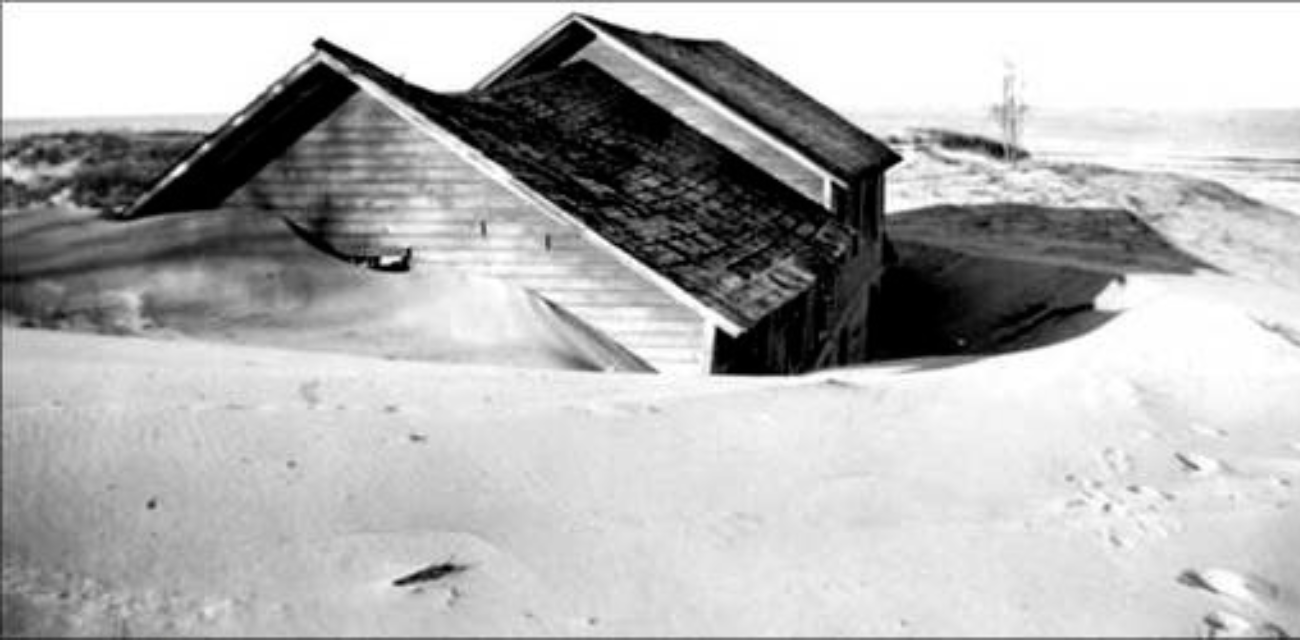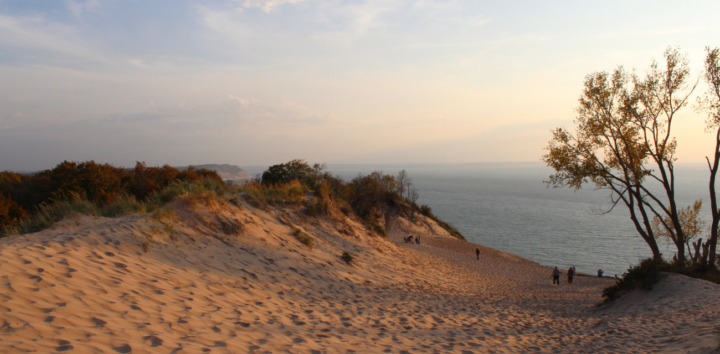From a sand-covered ghost town, Michigan’s dune story rises

Authored by
What lumber, wind and Singapore tell us about dunes and development
Ghost towns aren’t just found in out-west deserts. Some are in the dunes of west Michigan, too.
Nevertheless, Singapore—founded in 1835 next to what’s now the Saugatuck Dunes—has Wild West overtones. It had some mills, hotels, general stores and several hundred people. It had a sketchy “wildcat” bank that printed more money than it had. Desert towns had 40-day droughts; Singapore had a 40-day blizzard. The townsfolk allegedly survived on flour from a shipwreck near shore.
After blizzard came fire. Lots of it. Across the Great Lakes Basin, hundreds of people died and millions of acres of old-growth forest burned. Singapore was spared but it ramped up its lumber production to help Chicago rebuild after its own great fire in 1871. Two years later, all the trees around Singapore had been cleared. Then came the Saugatuck Dunes.
The newly flat, open, treeless space around Singapore allowed the wind to whip unfettered from the west, and it picked up the sand of the dunes right next to town. The dunes began to close in on Singapore—10 feet a year by old records. By the mid-1870s, the place was abandoned. By the 1970s, it was largely swallowed up. Now, only rumor remains: the tops of buildings reveal themselves from the dune bluffs, they say, only to be buried again.
Gears in the sand
It’s a perilous place, this earth. What’s reaped is sowed, even in our well-developed, present Michigan, full of beautiful coastal towns and free of shady banks and lumbar barons.
Singapore’s story shows this. It also shows that dunes are dynamic—they move, slow, sure waves across the beachline guided by the vegetation, wind and, especially now, human development. A healthy dunes goes beyond the majestic, bald crests of sand we know and love. It expands to the flora and fauna that hug them from behind.
Alter these things too much and dunes create sand in cities’ gears or the gears end up in our sands.
A few years back, researchers at Michigan State University pulled up old dunes photos from 40, 60, 100 years ago and took new photos from the very same spots. Some of the crests have since been covered with vegetation, a sign of a dune locked in. Others have been completely covered by roads.
But others remain strong. Changed a bit yes, but in no alarming way—to change is the nature of dunes. This means even those dunes that have suffered are capable of moving the right ways again. All things being good, the sands of Saugatuck can even slough off Singapore.
Preserving the Michigan dream
The relationship between humans and dunes may sound tensive, and in some places they are. But a strong relationship can and does exist, from New Buffalo on up to Glen Arbor and across the water to Grand Sable. It existed long before these places existed.
For years, the Michigan Environmental Council teamed with academic and science professionals to prove this. They took photos, talked to people, read local ordinances, mapped and studied, studied, studied. The result: social, economic and environmental proof that a good relationship between dunes and development is paramount.
Really, though, Michiganders don’t need studies to prove this. We love our dunes. Our sand draws in millions of visitors each year (and $139 million dollars). They’re the places we race down and ride around and lounge about on and daydream of in winter. They are the world’s largest assemblage of freshwater coastal dunes—a globally rare ecosystem—and they’ve become part of our culture.
We love dunes so much, we want to live right next to them—or at least visit them often. West coast counties have some of the highest population growth in the state. Vacation rentals are so popular, some communities are moving to limit them. And it all comes as Michigan catches itself up from a massive housing shortage. Sometimes we love something so much we start to hurt it.
From this dynamic—of ever-moving dunes and population—comes a campaign the Environmental Council is taking part in. We, member groups and local allies are taking our studies, experiences and ethos to create statewide policies that both protect our beloved dunes ecosystems and encourage humanity to wisely grow around them.
We’re bringing back the Michigan’s Critical Dunes Act, which will prevent sand getting in our gears and gears getting in our sand. We’re also working to bring more nature into our communities, as opposed to the erosive practices like our ghost town of Singapore.
You can follow our efforts through our communication arm: “Gears in the Sand.” We’ll tread through the political strife and smart policy solutions around dunes, and we’ll showcase the places and people who prove dunes and development can coexist together.

Discover
Power environmental change today.
Your gift to the Michigan Environmental Council is a powerful investment in the air we breathe, our water and the places we love.
Sign up for environmental news & stories.
"*" indicates required fields




